Dome Port Diaries - Chapter 4: Camera, Housing, Water
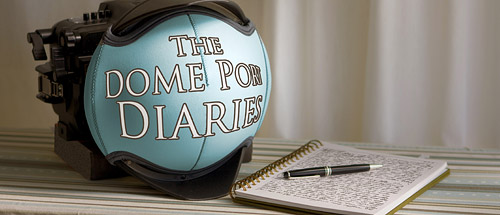
CHAPTER 4: CAMERA, HOUSING, WATER
Dunking an empty housing wasn’t much of a gamble, but adding a camera to the housing instantly created a variant of “Rock, Paper, Scissors” which I call “Camera, Housing, Water”. Camera is okay with housing, housing is okay with water, but camera is not okay with water. Or maybe it’s more like that puzzle where the farmer needs to get grain, a chicken, and a fox across a bridge, and can only carry two at a time. (Can’t leave the fox and chicken alone, nor the chicken and grain.) The goal, regardless of the combination, is to keep water away from the camera. Rock beats scissors, paper beats rock, scissors beats paper, water beats camera.
Back inside, I nestled my camera into the housing like an astronaut in a space capsule. I secured the mounting plate, engaged the gears, and attached the strobe connector. I carefully checked the O-ring (and by “carefully”, I mean that I must have rotated it 30 times checking for dust, hairs, ANYTHING that would bridge the in-side of the O-ring to the out-side), and headed back out to the pool. Laying down on the warm cement at the edge of the pool, arms extended straight out holding the housing over the water like a crane holding an unmanned submarine, I crossed my fingers around the handle.
The very first descent into the water was very brief. Once back out of the water, an absence of water was confirmed more thoroughly this time given its payload. Back in it went for a longer soak. When the housing was empty, the number of bubbles seemed a bit high, but reasonable. Now that the housing was occupied, it was as if 3 Alka-Seltzer tablets had been taped to the bottom. Bubbles seemed to emanate from every groove, crevice, port, and bracket. But, once swept away by a free hand, no additional bubbles appeared. 6 inches into the water, the first level of confidence was reached. Back down it went, a little deeper, for a bit longer. Dunk, lift, check, repeat.
Without actually opening the housing to confirm, all evidence pointed to a waterless black box. Yet, there was still this need in me to confirm it, to make contact with the camera, now submerged in arm-deep water; to confirm it was still “with me”, that it was still “there”, that it could “phone home”. The obvious test was to trigger the shutter. If water is hiding in the bottom of the housing and soaking the electronic innards of the camera, a lack of response will be the most obvious sign.
I pressed the shutter lever and, without hesitation, the camera grabbed its first (if unremarkable) shot.
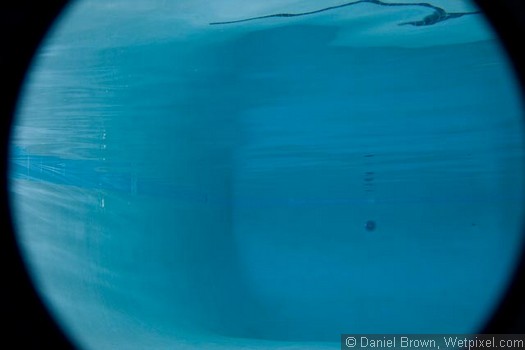
It’s my own version of the ultrasound photographs parents show of a baby. Meaningless from a visual standpoint, but tells an amazing story in a single frame. (Note that this was a 10-17 lens in a flat port; the 60mm lens wasn’t in yet. I tested the dome later in the day.)
A few more snaps assured the first shot wasn’t a fluke and that there was clearly no water in the housing. There’s something reassuring about hearing the shutter operate; like the “pulse” of the camera, proof that it’s electronically still alive; like “pings” from a probe landing on Mars. Though the camera was held in my extended arms, its environment made it feel out of reach.
Having quickly transitioned from paranoid to assured, I set the submerged rig on the steps of the pool, confident enough in the housing as to suddenly pretend to be casual about it, and climbed in.
Three things quickly became clear:
1. Holding a camera, it’s much easier to swim with fins on. 2. I hate snorkeling. (I knew that already, but this was a solid reminder.) 3. There’s really NOTHING to take a picture of in a pool.
Later that same day, I found something to photograph, but I’ll save that for the next chapter.
by Daniel Brown

Dome Port Diaries
The Adventures of a Newbie Housing Owner
——-
Joel Penner, who was also at the Bonaire Digital Shootout, took some pool shots when he first got his camera too. Seems I’m not the first to find (brief) inspiration in a pool. He was much more creative, however. Thanks to Joel for agreeing to let us show his photos!
Anyone else out there willing to share those early shots? By all means, post away in the comments. We’d love to see them!
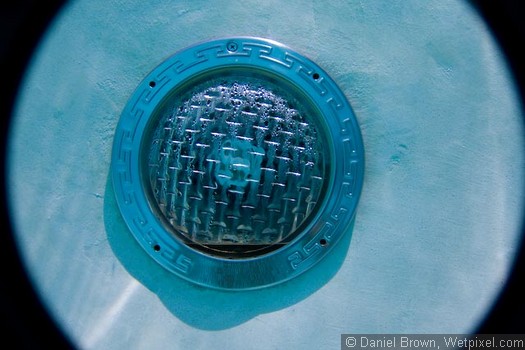
I like this shot in part because people seem to know what it is, maybe harkening back to childhood when it was, other than the drain, the only noteworthy feature in a pool.
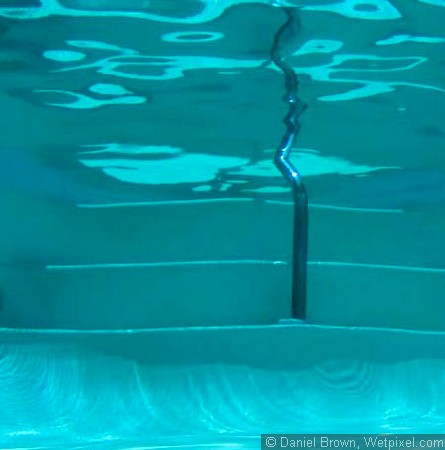
This was about as interesting as I could get.
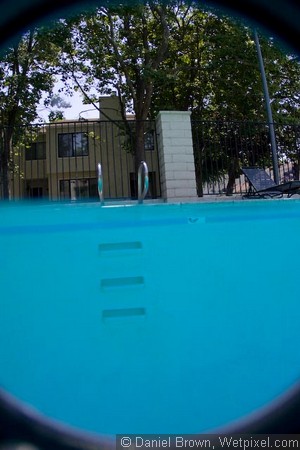
The easiest over/under shot I’ve ever done.